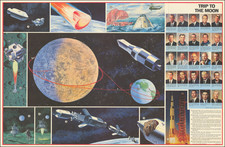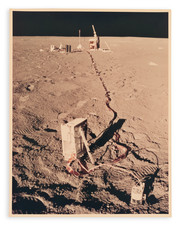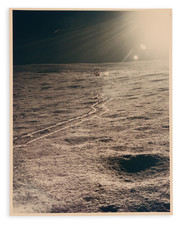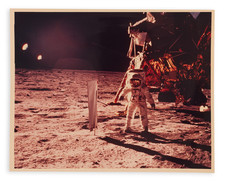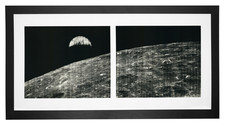Tracking Apollo 13 Across the Near Side of the Moon
Detailed photographic image of the surface of the moon, tracking the course of Apollo 13 on its mission of April 1970.
From left to right, the left side shows the easternmost edge of the Moon's near side, transitioning to the far or dark side of the moon.
Named features on the Dark Side of the moon include the Tsiolkovsky Crater, a large lunar impact crater that is located on the far side of the Moon. Named for Russian scientist Konstantin Tsiolkovsky, it lies in the southern hemisphere, to the west of the large crater Gagarin, and northwest of Milne. Just to the south is Waterman, with Neujmin to the south-southwest. The crater protrudes into the neighboring Fermi, an older crater of comparable size that does not have a lava-flooded floor. Also named is the Sea of Moscow.
At the far left (near side) several dozen more craters and sas are named, including Smyth's Sea, the Sea of Crises, Border Sea, Foaming Sea, Langrenus Crator and Vendelinus and Vendelinus L (the Latin name named for Godefroy Wendelin, a famed 17th Century astronomer who early in his career was asked by Plantijn publisher Balthasar Moretus in 1618 to draft the text for the a new edition of Ortelius's Theatrum Orbis Terrarum, which was never completed).
The Lunar Orbital Science Flight Chart illustrates a small piece of an epoch in which humanity strove to deepen its understanding of the Moon's geology and geography. Launched on April 11, 1970, Apollo 13 was originally intended to be the third mission to land astronauts on the Moon, but it turned into a perilous endeavor of survival and technical ingenuity due to an in-flight mechanical failure.
Apollo 13's mission, although infamous for its near-disastrous outcome, was positioned at the forefront of lunar science during a decade marked by escalating space competition and geo-political rivalry, predominantly between the United States and the Soviet Union. The 1960s had witnessed the first successful lunar landing by Apollo 11, and the subsequent Apollo 12 mission had further established the feasibility of lunar exploration. In this context, the Apollo 13 mission was designed to go beyond mere demonstration of technical prowess; it aimed to conduct substantial scientific experiments and studies on the Moon.
Covering REV 1 through 18—REV referring to Revolution, or an orbit around the Moon—the chart in question offers a detailed graphic representation of a section of the Moon's surface crossed 18 times by Apollo 13.












